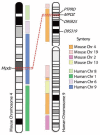Discovering genes involved in alcohol dependence and other alcohol responses: role of animal models
- PMID: 23134054
- PMCID: PMC3860408
Discovering genes involved in alcohol dependence and other alcohol responses: role of animal models
Abstract
The genetic determinants of alcoholism still are largely unknown, hindering effective treatment and prevention. Systematic approaches to gene discovery are critical if novel genes and mechanisms involved in alcohol dependence are to be identified. Although no animal model can duplicate all aspects of alcoholism in humans, robust animal models for specific alcohol-related traits, including physiological alcohol dependence and associated withdrawal, have been invaluable resources. Using a variety of genetic animal models, the identification of regions of chromosomal DNA that contain a gene or genes which affect a complex phenotype (i.e., quantitative trait loci [QTLs]) has allowed unbiased searches for candidate genes. Several QTLs with large effects on alcohol withdrawal severity in mice have been detected, and fine mapping of these QTLs has placed them in small intervals on mouse chromosomes 1 and 4 (which correspond to certain regions on human chromosomes 1 and 9). Subsequent work led to the identification of underlying quantitative trait genes (QTGs) (e.g., Mpdz) and high-quality QTG candidates (e.g., Kcnj9 and genes involved in mitochondrial respiration and oxidative stress) and their plausible mechanisms of action. Human association studies provide supporting evidence that these QTLs and QTGs may be directly relevant to alcohol risk factors in clinical populations.
Figures


Similar articles
-
Identifying quantitative trait loci (QTLs) and genes (QTGs) for alcohol-related phenotypes in mice.Int Rev Neurobiol. 2010;91:173-204. doi: 10.1016/S0074-7742(10)91006-4. Int Rev Neurobiol. 2010. PMID: 20813243 Review.
-
Mapping a locus for alcohol physical dependence and associated withdrawal to a 1.1 Mb interval of mouse chromosome 1 syntenic with human chromosome 1q23.2-23.3.Genes Brain Behav. 2008 Jul;7(5):560-7. doi: 10.1111/j.1601-183X.2008.00391.x. Genes Brain Behav. 2008. PMID: 18363856
-
Mapping a barbiturate withdrawal locus to a 0.44 Mb interval and analysis of a novel null mutant identify a role for Kcnj9 (GIRK3) in withdrawal from pentobarbital, zolpidem, and ethanol.J Neurosci. 2009 Sep 16;29(37):11662-73. doi: 10.1523/JNEUROSCI.1413-09.2009. J Neurosci. 2009. PMID: 19759313 Free PMC article.
-
Molecular analyses and identification of promising candidate genes for loci on mouse chromosome 1 affecting alcohol physical dependence and associated withdrawal.Genes Brain Behav. 2008 Jul;7(5):599-608. doi: 10.1111/j.1601-183X.2008.00396.x. Genes Brain Behav. 2008. PMID: 18363851
-
A comparison of selected quantitative trait loci associated with alcohol use phenotypes in humans and mouse models.Addict Biol. 2010 Apr;15(2):185-99. doi: 10.1111/j.1369-1600.2009.00195.x. Addict Biol. 2010. PMID: 20148779 Free PMC article. Review.
Cited by
-
Polymorphisms in early neurodevelopmental genes affect natural variation in alcohol sensitivity in adult drosophila.BMC Genomics. 2015 Oct 26;16:865. doi: 10.1186/s12864-015-2064-5. BMC Genomics. 2015. PMID: 26503115 Free PMC article.
-
What Is Addiction? How Can Animal and Human Research Be Used to Advance Research, Diagnosis, and Treatment of Alcohol and Other Substance Use Disorders?Alcohol Clin Exp Res. 2019 Jan;43(1):6-21. doi: 10.1111/acer.13912. Epub 2018 Dec 3. Alcohol Clin Exp Res. 2019. PMID: 30371956 Free PMC article.
-
The multiple PDZ domain protein Mpdz/MUPP1 regulates opioid tolerance and opioid-induced hyperalgesia.BMC Genomics. 2016 Apr 29;17:313. doi: 10.1186/s12864-016-2634-1. BMC Genomics. 2016. PMID: 27129385 Free PMC article.
-
Introduction to sequencing the brain transcriptome.Int Rev Neurobiol. 2014;116:1-19. doi: 10.1016/B978-0-12-801105-8.00001-1. Int Rev Neurobiol. 2014. PMID: 25172469 Free PMC article. Review.
-
Effect of chronic ethanol consumption in rhesus macaques on the nucleus accumbens core transcriptome.Addict Biol. 2021 Sep;26(5):e13021. doi: 10.1111/adb.13021. Epub 2021 May 4. Addict Biol. 2021. PMID: 33942443 Free PMC article.
References
-
- Addolorato G, Leggio L, Abenavoli L, et al. Baclofen in the treatment of alcohol withdrawal syndrome: A comparative study vs diazepam. American Journal of Medicine. 2006;119(3):276.e213–278. - PubMed
-
- Bailey SM. A review of the role of reactive oxygen and nitrogen species in alcohol-induced mitochondrial dysfunction. Free Radical Research. 2003;37(6):585–596. - PubMed
-
- Balasubramanian S, Fam SR, Hall RA. GABABreceptor association with the PDZ scaffold Mupp1 alters receptor stability and function. Journal of Biological Chemistry. 2007;282(6):4162–4171. - PubMed
-
- Becamel C, Figge A, Poliak S, et al. Interaction of serotonin 5-hydroxytryptamine type 2C receptors with PDZ10 of the multi-PDZ domain protein MUPP1. Journal of Biological Chemistry. 2001;276(16):12974–12982. - PubMed
-
- Belknap JK, Atkins AL. The replicability of QTLs for murine alcohol preference drinking behavior across eight independent studies. Mammalian Genome. 2001;12(12):893–899. - PubMed
Publication types
MeSH terms
Substances
Grants and funding
LinkOut - more resources
Full Text Sources
Medical

